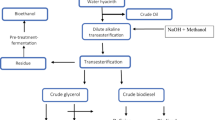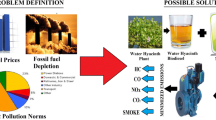Abstract
Biodiesels obtained from aquatic biomass such as Water Hyacinth and Salvinia Molesta are discussed as potential blending substance in pure diesel. Biodiesel not only supports the economy of fuel but also saves the environment by decreasing the pollution levels. Aquatic weeds create various kinds of problems in ecosystem. One of the main issues is their fast growth which clogs the waterways. But this problem also offers a great opportunity to build a biofuel economy based on biomass of aquatic weeds. There is no need of investment of money for production of this biomass as it is considered as a waste till date. Government has to spend money to clean the water body from these aquatic weeds. Use of this waste in production of biodiesel confirms two objectives simultaneously, firstly it supports the Atmanirbhar Bharat by building our own fuel and secondly it generates wealth from waste. This paper highlights the potential of Water Hyacinth biodiesel (WHB) and Salvinia Molesta biodiesel as alternative fuels for diesel engines.
Access this chapter
Tax calculation will be finalised at checkout
Purchases are for personal use only
Similar content being viewed by others
Abbreviations
- B0:
-
0% Biodiesel in fuel + 100% Diesel
- B10:
-
10% Biodiesel in fuel + 90% Diesel
- B20:
-
20% Biodiesel in fuel + 80% Diesel
- B30:
-
30% Biodiesel in fuel + 70% Diesel
- B40:
-
40% Biodiesel in fuel + 60% Diesel
- B100:
-
100% Biodiesel in fuel + 0% Diesel
- CI:
-
Compression ignition
- CO:
-
Carbon monoxide
- CO2:
-
Carbon dioxide
- HRR:
-
Heat release rate
- PM:
-
Particulate matter
- O2:
-
Oxygen
References
Konwar LJ, Boro J, Deka D (2014) Review on latest developments in biodiesel production using carbon-based catalysts. Renew Sustain Energy Rev 29:546–564. https://doi.org/10.1016/j.rser.2013.09.003
Yusuf NNAN, Kamarudin SK, Yaakub Z (2011) Overview on the current trends in biodiesel production. Energy Convers Manage 52:2741–2751. https://doi.org/10.1016/j.enconman.2010.12.004
Demirbas A (2009) Progress and recent trends in biodiesel fuels. Energy Convers Manage 50:14–34. https://doi.org/10.1016/j.enconman.2008.09.001
Issariyakul T, Dalai AK, Desai P (2011) Evaluating esters derived from mustard oil (Sinapis alba) as potential diesel additives. JAOCS, J Am Oil Chem Soc 88:391–402. https://doi.org/10.1007/s11746-010-1679-6
Saladini F, Patrizi N, Pulselli FM, Marchettini N, Bastianoni S (2016) Guidelines for emergy evaluation of first, second and third generation biofuels. Renew Sustain Energy Rev 66:221–227. https://doi.org/10.1016/j.rser.2016.07.073
Bhuiya MMK, Rasul MG, Khan MMK, Ashwath N, Azad AK, Hazrat MA (2014) Second generation biodiesel: potential alternative to-edible oil-derived biodiesel. Energy Procedia 61:1969–1972. https://doi.org/10.1016/j.egypro.2014.12.054
Atadashi IM, Aroua MK, Aziz AA (2010) High quality biodiesel and its diesel engine application: a review. Renew Sustain Energy Rev 14:1999–2008. https://doi.org/10.1016/j.rser.2010.03.020
Umdu ES, Tuncer M, Seker E (2009) Transesterification of Nannochloropsis oculata microalga’s lipid to biodiesel on Al2O3 supported CaO and MgO catalysts. Biores Technol 100:2828–2831. https://doi.org/10.1016/j.biortech.2008.12.027
Huang GH, Chen F, Wei D, Zhang XW, Chen G (2010) Biodiesel production by microalgal biotechnology. Appl Energy 87:38–46. https://doi.org/10.1016/j.apenergy.2009.06.016
Raju V, Kishore PS, Nanthagopal K, Ashok B (2018) An experimental study on the effect of nanoparticles with novel tamarind seed methyl ester for diesel engine applications. Energy Convers Manage 164:655–666. https://doi.org/10.1016/j.enconman.2018.03.032
Atabani AE, Mahlia TMI, Anjum Badruddin I, Masjuki HH, Chong WT, Lee KT (2013) Investigation of physical and chemical properties of potential edible and non-edible feedstocks for biodiesel production, a comparative analysis. Renew Sustain Energy Rev 21:749–755. https://doi.org/10.1016/j.rser.2013.01.027
Zhong W, Xuan T, He Z, Wang Q, Li D, Zhang X et al (2016) Experimental study of combustion and emission characteristics of diesel engine with diesel/second-generation biodiesel blending fuels. Energy Convers Manage 121:241–250. https://doi.org/10.1016/j.enconman.2016.05.033
Srinophakun P, Thanapimmetha A, Rattanaphanyapan K, Sahaya T, Saisriyoot M (2017) Feedstock production for third generation biofuels through cultivation of Arthrobacter AK19 under stress conditions. J Clean Prod 142:1259–1266. https://doi.org/10.1016/j.jclepro.2016.08.068
Venu H, Venkataraman D, Purushothaman P, Vallapudi DR (2019) Eichhornia crassipes biodiesel as a renewable green fuel for diesel engine applications: performance , combustion , and emission characteristics. Environ Sci Pollut Res 26:18084–18097. https://doi.org/10.1007/s11356-019-04939-z
Alagu K, Venu H, Jayaraman J, Raju VD, Subramani L, Appavu P et al (2019) Novel Water Hyacinth biodiesel as a potential alternative fuel for existing unmodified diesel engine: performance , combustion and emission characteristics. Energy 179:295–305. https://doi.org/10.1016/j.energy.2019.04.207
Ganguly A, Chatterjee PK, Dey A (2012) Studies on ethanol production from Water Hyacinth—A review. Renew Sustain Energy Rev 16:966–972. https://doi.org/10.1016/j.rser.2011.09.018
Bote MA, Naik VR, Jagadeeshgouda KB (2020) Materials science for energy technologies review on Water Hyacinth weed as a potential bio fuel crop to meet collective energy needs. Mater Sci Energy Technol 3:397–406. https://doi.org/10.1016/j.mset.2020.02.003
Awasthi M, Kaur J, Rana S (2013) Bioethanol production through Water Hyacinth, Eichhornia crassipes via optimization of the pretreatment conditions. Int J Emerg Technol Adv Eng 3:42–46
Gielen D, Boshell F, Saygin D, Bazilian MD, Wagner N, Gorini R (2019) The role of renewable energy in the global energy transformation. Energy Strateg Rev 24:38–50. https://doi.org/10.1016/j.esr.2019.01.006
Mubarak M, Shaija A (2016) Ultrasonication: An effective pre-treatment method for extracting lipid from Salvinia Molesta for biodiesel production. Resour Technol 2:126–132. https://doi.org/10.1016/j.reffit.2016.07.005
Mubarak M, Shaija A, Suchithra TV (2016) Ultrasonication: An effective pre-treatment method for extracting lipid from Salvinia molesta for biodiesel production. Resour Efficient Technol 2(3): 126–132. https://doi.org/10.1016/j.reffit.2016.07.005
Mubarak M, Shaija A, Suchithra TV (2020) Experimental evaluation of Salvinia Molesta oil biodiesel/diesel blends fuel on combustion, performance and emission analysis of diesel engine. Fuel 287: 119526. https://doi.org/10.1016/j.fuel.2020.119526
Shanab SMM, Hanafy EA, Shalaby EA (2016) Water Hyacinth as non-edible source for biofuel production. Waste Biomass Valor. https://doi.org/10.1007/s12649-016-9816-6
Rahman MA, Aziz MA (2021) Biodiesel from Water Hyacinth biomass and its influence on CI engine performance , emission , combustion and heat loss characteristics with the induction of hydroxy. Energy 24:120151. https://doi.org/10.1016/j.energy.2021.120151
Alam NS, Singh B, Guldhe A (2021) Aquatic weed as a biorefinery for biofuels and value-added products: challenges and recent advancements. Cleaner Eng Technol. https://doi.org/10.1016/j.clet.2021.100235
Mishima D, Kuniki M, Sei K, Soda S, Ile M, Fujita M (2008) Ethanol production from candidate energy crops: Water hyacinth (Eichhornia crassipes) and water lettuce (Pistiaatratiotes L.). Bioresour Technol 99:2495–2500. https://doi.org/10.1016/j.biortech.2005.09.029
Xu J, Cui W, Cheng JJ, Stomp AM (2011) Production of high-starch duckweed and its conversion to bioethanol. Biosyst Eng 110:67–72. https://doi.org/10.1016/j.biosystemseng.2011.06.007
Abbasi SA, Naseema A, Nipaney PC (1995) Productivity (net primary production) of salvinia (Salvinia molesta, Mitchell) in nature environments. Int J Resour Conserv, pp 215–220
Jayus L, Nurhayati N, Mayzhuroh A, Arindhani S, Caroenchai C (2016) Studies on bioethanol production of commercial baker’s and alcohol yeast under aerated culture using sugarcane molasses as the media. Agric Agric Sci procedia 9:493–499. https://doi.org/10.1016/j.aaspro.2016.02.168
McAloon A, Taylorr F, Yee W, Ibsen K, Wooley R (2000) Determining the cost of producing ethanol from corn starch and lignocellulosic feedstock. National Renewable Energy Lab. Golden CO(US). https://doi.org/10.2172/766198
Williams J, Brammer J, Llewelyn R, Bergtold J (2016) An economic analysis of harvesting biomass from sorghums and corn. J AASFMRA, pp 89–101. https://doi.org/10.22004/ag.econ.236656
Satputaley SS, Zodpe DB, Deshpande NV (2018) ScienceDirect performance, combustion and exhaust emissions analysis of a diesel engine fuelled with algae oil and algae biodiesel. Mater Today Process 5:23022–23032. https://doi.org/10.1016/j.matpr.2018.11.031
Nautiyal P, Subramanian KA, Dastidar MG, Kumar A (2020) Experimental assessment of performance , combustion and emissions of a compression ignition engine fuelled with Spirulina platensis biodiesel. Energy 193. https://doi.org/10.1016/j.energy.2019.116861
Meng X, Chen G, Wang Y (2008) Biodiesel production from waste cooking oil via alkali catalyst and its engine test. Fuel Process Technol 9:5–11. https://doi.org/10.1016/j.fuproc.2008.02.006
Mani M, Subash C, Nagarajan G (2009) Performance, emission and combustion characteristics of a DI diesel engine using waste plastic oil. Appl Therm Eng 29:2738–2744. https://doi.org/10.1016/j.applthermaleng.2009.01.007
Arefin MA, Rashid F, Islam A (2021) A review of biofuel production from floating aquatic plants : an emerging source of bio-renewable energy. Biofuels, Bioprod Biorefin 15:574–591. https://doi.org/10.1002/bbb.2180
Thiruvenkatachari S, Saravanan CG, Geo VE, Vikneswaran M, Udayakumar R (2022) Experimental investigations on the production and testing of azolla methyl esters from Azolla microphylla in a compression ignition engine. Fuel 119448. https://doi.org/10.1016/j.fuel.2020.119448
Author information
Authors and Affiliations
Corresponding author
Editor information
Editors and Affiliations
Rights and permissions
Copyright information
© 2023 The Author(s), under exclusive license to Springer Nature Singapore Pte Ltd.
About this paper
Cite this paper
Jain, A., Bora, B.J., Kumar, R., Buradi, A. (2023). Comparative Study of Performance and Emission of Biodiesel Produced from Water Hyacinth and Salvinia Molesta: A Critical Review. In: Revankar, S., Muduli, K., Sahu, D. (eds) Recent Advances in Thermofluids and Manufacturing Engineering. Lecture Notes in Mechanical Engineering. Springer, Singapore. https://doi.org/10.1007/978-981-19-4388-1_33
Download citation
DOI: https://doi.org/10.1007/978-981-19-4388-1_33
Published:
Publisher Name: Springer, Singapore
Print ISBN: 978-981-19-4387-4
Online ISBN: 978-981-19-4388-1
eBook Packages: EngineeringEngineering (R0)




